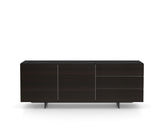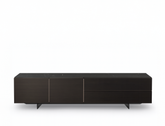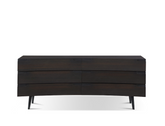Bar Stool Shopping Made Easy

Bar stools are an excellent addition to any home, providing versatile seating options for your kitchen, dining room, or even outdoor spaces. With their ability to enhance the look of any room, bar stools have become a popular choice among homeowners looking to add a touch of style and functionality to their living spaces. However, choosing the right bar stools can be challenging, especially when trying to match them to your space's layout and design. In this guide, we’ll walk you through everything you need to know about selecting the perfect bar stools for your home.
Understanding Bar Stool Height and Size
One of the most critical aspects of choosing bar stools is ensuring they are the correct height for your counter or bar. The right bar stool height allows you to sit comfortably with your legs tucked under the table or counter, creating an ergonomic fit that enhances your overall comfort.
Standard Bar Stool Heights:
- Bar-Height Stools: These stools typically have a seat height of 29 to 32 inches, making them ideal for counters that are 41 to 43 inches tall. These are perfect for kitchen bars and standard-height countertops.
- Counter-Height Stools: With a seat height of 23 to 28 inches, these stools are designed for counters that stand 35 to 37 inches high, commonly found in kitchens and dining areas.
- Adjustable Bar Stools: For a more versatile seating solution, consider adjustable bar stools that can be modified to fit a variety of counter heights, offering flexibility and adaptability.
Measuring Your Space: To ensure your bar stools fit perfectly, measure the height of your counter from the floor to the top, and then subtract approximately 12 inches. This measurement allows for sufficient legroom, ensuring you can sit comfortably without feeling cramped. Additionally, consider any armrests or additional features that may require extra space between the stool and the counter.
Determining the Ideal Distance Between Bar Stools
Spacing is another essential factor when arranging bar stools. Proper spacing ensures that everyone seated has enough room to move comfortably without feeling crowded.
Recommended Spacing:
- Between Stools: Leave at least 6 inches (15 cm) between each bar stool. This spacing allows for ease of movement and ensures that each person has enough room to sit comfortably.
- Against a Wall: If your bar stools are placed against a wall, ensure there is enough space between the backrest and the wall. This allows for comfortable seating and easy movement around the area.
Choosing Between a Bar Stool with a Back or No Back
When it comes to comfort and style, deciding whether to choose a bar stool with a backrest or without is essential. Both options have their own set of advantages and can significantly influence the overall look and feel of your space.
Backless Bar Stools:
- Style: Backless stools are often sleek and minimalist, taking up less visual space and keeping the focus on your counter or bar area.
- Comfort: These stools are great for short stays or quick meals but may not be the best option for extended sitting periods.
Bar Stools with Backrests:
- Style: Stools with backrests can add a more substantial and defined look to your space, often making the seating area feel more grounded and complete.
- Comfort: These stools offer more support and are better suited for longer periods of sitting, making them ideal for areas where you might linger, such as a kitchen island or bar.
Should You Choose Bar Stools with or Without Armrests?
Armrests can add a layer of comfort to your bar stools, but they also take up more space, which is a crucial consideration, especially in smaller areas.
Bar Stools with Armrests:
- Comfort: Armrests provide additional comfort, making these stools ideal for longer periods of sitting.
- Space Considerations: When choosing stools with armrests, ensure you have enough space. Armrests can add width to the stool, potentially reducing the number of stools you can fit along your counter.
Bar Stools without Armrests:
- Style: These stools offer a more streamlined look and are easier to fit into tight spaces.
- Versatility: Without armrests, these stools can be easily moved around and are generally lighter, making them a flexible seating option.
Exploring Different Bar Stool Styles
The style of your bar stool can significantly impact the overall aesthetic of your space. With a wide range of designs available, you can choose a style that complements your existing decor or adds a new element of interest.
Bistro Style Bar Stools:
- Design: Bistro bar stools often feature a tall backrest and a simple, rustic design, making them perfect for creating a cafe-like atmosphere in your kitchen or dining area.
- Versatility: These stools are ideal for those looking to add a touch of elegance and charm to their space without overwhelming the existing decor.
Bucket Bar Stools:
- Design: Known for their sturdy build and comfortable seating, bucket bar stools are commonly found in commercial settings like restaurants and bars.
- Comfort: With their thick cushioning and supportive design, bucket bar stools offer a high level of comfort, making them a great choice for home bars and dining areas.
Swivel Bar Stools:
- Functionality: As the name suggests, swivel bar stools feature a rotating seat, allowing you to turn and adjust your position without moving the entire stool. This functionality can help prevent floor damage and increase the stool's longevity.
- Consideration: When selecting swivel stools, ensure there is enough space between them, as they can be larger and require more room to rotate freely.
Stationary Bar Stools:
- Design: Unlike swivel stools, stationary bar stools have fixed seats, meaning you’ll need to physically move the stool to change your position.
- Advantages: Stationary stools can be positioned precisely and tend to stay in place, making them a good option for areas where you want a more structured and stable seating arrangement.
Selecting the Right Seat Materials
The material of your bar stool’s seat not only influences its comfort but also its durability and ease of maintenance. When choosing a material, consider how the stool will be used and how it will fit with your overall design aesthetic.
Metal Bar Stools:
- Durability: Metal stools are incredibly durable and can withstand heavy use, making them a practical choice for busy areas like kitchens and bars.
- Style: Metal stools often have a sleek, industrial look, making them ideal for modern or contemporary spaces. However, they may not be the most comfortable option for long periods of sitting unless paired with cushions.
Wood Bar Stools:
- Versatility: Wooden stools offer a classic and versatile look that can complement a wide range of decor styles, from traditional to rustic to modern.
- Comfort: While wood can be a harder material, many wooden stools come with cushioned seats or upholstered options to enhance comfort.
Upholstered Bar Stools:
- Comfort: Upholstered stools provide a higher level of comfort, especially for extended sitting. They often feature plush cushioning and soft fabrics that can make your seating area feel more inviting.
- Style: Upholstered stools are available in a variety of fabrics, leather, and designs, making them a great choice for adding a touch of luxury or personalization to your space.
Final Thoughts
Choosing the right bar stools for your home involves more than just selecting a style that catches your eye. It’s about finding the perfect balance between comfort, functionality, and aesthetics that aligns with your space. By considering factors such as stool height, spacing, backrests, armrests, and materials, you can select bar stools that not only enhance the look of your room but also provide a comfortable and inviting seating option for you and your guests.
Frequently Asked Questions
1. What is the standard height for bar stools?
- Standard bar stools typically have a seat height of 29 to 32 inches, suitable for counters that are 41 to 43 inches high.
2. How much space should be between bar stools?
- It’s recommended to leave at least 6 inches (15 cm) of space between each bar stool to ensure comfortable seating and movement.
3. Are bar stools with backs more comfortable?
- Bar stools with backs generally offer more support and are more comfortable for longer periods of sitting compared to backless stools.
4. What material is best for bar stools?
- The best material depends on your needs; metal is durable and easy to clean, wood offers versatility and warmth, and upholstered stools provide maximum comfort.
5. Can I use bar stools at a dining table?
- Yes, counter-height bar stools can be used with dining tables if the table height matches the stool height, providing an alternative seating option.
6. How do I choose between swivel and stationary bar stools?
- Choose swivel stools if you want the flexibility to turn without moving the stool, and opt for stationary stools if you prefer a stable, fixed seating option.
By following these guidelines and considering your specific needs, you'll be well-equipped to choose the perfect bar stools that enhance both the functionality and style of your home.







